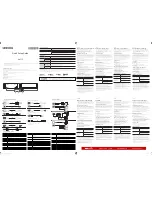
CAUTION INSTRUCTIONS FOR L&L KILNS
cautions.pdf
REV: 11/1/2016
Page 6
2016
L&L Kiln Mfg, Inc. 505 Sharptown Rd, Swedesboro NJ 08085 P:856.294.0077 F:856.294.0070 [email protected] hotkilns.com
calculate ventilation requirements for a kiln room:
hotkilns.com/calculate-kiln-room-ventilation
5. Aside from issues of ventilating the fumes from the firing,
the heat build up in an enclosed room could present a
significant fire hazard. See the INSTALLATION cautions.
6. Severe corrosion can be caused by kiln fumes, salt air or
other environmental conditions.
7. Good venting can minimize these problems.
8. Ventilation must be to the outside.
9. Be careful not to locate the outlet of the vent near an
open window.
AMBIENT TEMPERATURES
1. The kiln should operate in an environment that is
between -18°C (0°F ) and 38°C (100°F).
2. Note that the control, if set up for degrees centigrade,
may give you an error code if room temperature drops
below 0°C (32°F). The DynaTrol and most other controls do
not handle negative numbers.
SURFACE IS HOT AND CAN CAUSE BURNS
1. Kiln surface can be extremely hot: up to 260°C (500°F).
2. You can be severely burned if you touch the hot surface.
3. Display a sign near the kiln that specifically warns
everyone of how hot the kiln is.
KEEP CHILDREN/ANIMALS AWAY FROM KILN
1. Protect any children, animals, and unqualified adults
(anyone who is not able to understand these cautions) that
may be near the kiln.
2. Aside from fumes that must be ventilated, and flammability
concerns, they must be protected from the heat of the kiln
and the electrical dangers.
3. Ideally, the kiln should be secured in a space away from
any children (especially in a schoolroom situation where
children might not always follow safety precautions).
KEEP FLAMMABLES AWAY FROM KILN
1. Do not put sealed containers or combustible materials
such as solvents, paper, rags, kerosene, paints, cesium,
magnesium, aluminum powder, calcium, sawdust, plastic
dust, coal, flour and powdered metal., in or near kiln. An
explosion or fire could result.
2. The kiln elements could act as an ignitor of flammable
fumes when hot.
PRACTICE GOOD HYGIENE
1. Clay contains silica dust which can be harmful (see silica
caution) and some glazes contain heavy metals such as
lead, cadmium and copper.
2. While this caution is outside the scope of kiln safety it is
worth mentioning here.
3. Keep your room clean and your kiln clean.
PROPER USE OF KILN WASH
1. Make sure the floor of the kiln and the tops of the shelves
are coated with kiln wash.
2. This will protect these surfaces from melting glaze and
ceramics.
3. Do not coat the undersides or sides of the shelves.
4. Do not apply kiln wash to the brick sides or element
holders. (Damage to the elements could result).
5. If you have a kiln sitter, put kiln wash on the cone
supports (not the sensing rod) for accurate cone action.
6. Clean off the old wash and reapply new wash each time
you fire or when it begins to chip away.








































